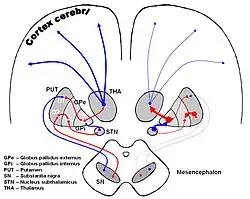Thalamic fasciculus
| Thalamic fasciculus | |
|---|---|
 The image shows dopaminergic pathways of the human brain in normal condition (left) and Parkinsons Disease (right). Red Arrows indicate suppression of the target, blue arrows indicate stimulation of target structure. (Thalamic fasciculus visible but not labeled, as red line from GPi to THA.) | |
| Details | |
| Identifiers | |
| Latin | fasciculus thalamicus |
| NeuroNames | 439 |
| TA98 | A14.1.08.679 A14.1.09.523 |
| TA2 | 5756 |
| FMA | 62065 |
| Anatomical terms of neuroanatomy | |
The thalamic fasciculus is a component of the subthalamus. It is synonymous with field H1 of Forel. Nerve fibres form a tract containing cerebellothalamic (crossed) and pallidothalamic (uncrossed) fibres, that is insinuated between the thalamus and the zona incerta.
The thalamic fasciculus consists of fibers from the ansa lenticularis and from the lenticular fasciculus, coming from different portions of the medial globus pallidus, before they jointly enter the ventral anterior nucleus of the thalamus.[1]
References
- ↑ Estomih Mtui; Gregory Gruener (2006). Clinical Neuroanatomy and Neuroscience: With STUDENT CONSULT Online Access. Philadelphia: Saunders. p. 359. ISBN 1-4160-3445-5.
{{cite book}}: CS1 maint: multiple names: authors list (link)
External links
- http://www.meddean.luc.edu/lumen/MedEd/Neuro/frames/nlDEs/nl06fr.htm
- https://web.archive.org/web/20070419222336/http://www.endotext.org/neuroendo/neuroendo3b/neuroendo3b_2.htm (see figure #12)
- https://web.archive.org/web/20080504234454/http://isc.temple.edu/neuroanatomy/lab/atlas/mdbg/
This article is issued from Offline. The text is licensed under Creative Commons - Attribution - Sharealike. Additional terms may apply for the media files.